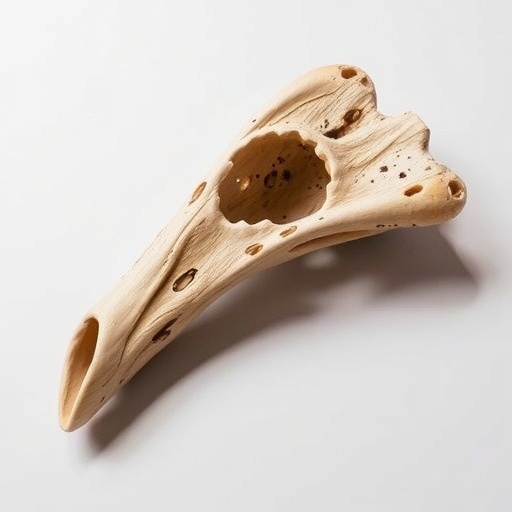New research spearheaded by palaeontologists at UNSW Sydney has cast significant doubt on the long-held belief that Indigenous Australians were responsible for the extinction of Australia’s megafauna through hunting. Instead, emerging evidence suggests that these first peoples may have engaged primarily in fossil collecting, highlighting a complex prehistoric relationship with these giant creatures rather than outright predation.
The crux of this revised narrative lies in a fossilized tibia bone of a colossal ‘sthenurine’ kangaroo species discovered over a century ago in Mammoth Cave, southwestern Australia. This particular bone became a cornerstone in earlier scientific discourse because of a distinctive incision on its surface, which was interpreted in a landmark 1980 study as proof that Indigenous Australians actively hunted and butchered megafaunal animals. This interpretation, led by renowned palaeontologist Professor Mike Archer, helped cement the hypothesis that human arrival and megafaunal extinction were causally linked approximately 65,000 years ago.
However, with advances in imaging and dating technology, the validity of this interpretation has come under fresh scrutiny. Utilizing modern micro-computed tomography (microCT) scanning and refined radiometric dating techniques, researchers re-examined the leg bone and its enigmatic cut. This non-destructive, high-resolution 3D imaging revealed that the incision was inflicted not on fresh bone but on a dry, fossilized specimen already exhibiting shrinkage cracks. Such findings strongly indicate that the cut occurred long after the animal’s death, thus negating previous claims that it was a mark of butchery inflicted by humans during hunting.
This reinterpretation has profound implications for understanding the complex dynamics between Australia’s First Peoples and megafaunal species. For decades, the Mammoth Cave bone served as a ‘smoking gun’ in the debate over whether Indigenous Australians contributed significantly to the extinction of these colossal animals. The overturning of this evidence reopens scientific dialogue, casting uncertainty on human culpability and accentuating the potential roles of other environmental factors.
Complementing this bone study, researchers also examined a fossil tooth pendant belonging to the extinct marsupial Zygomaturus trilobus, discovered in the Kimberley region of northwestern Australia. This precious object was gifted by a member of the Worora Nation in the 1960s, highlighting cultural connections to prehistoric animals. Intriguingly, comparative analyses showed the tooth’s morphology and mineral composition matched fossils from Mammoth Cave, several hundred kilometers distant, suggesting the pendant was transported—potentially traded or carried—across vast distances.
The presence of such an artifact signifies a sophisticated prehistoric practice of fossil collection by Indigenous groups, likely predating European scientific interest by thousands of years. This cultural engagement with fossils hints at early palaeontological curiosity, elevating these communities to the status of some of the world’s first natural historians. It indicates that megafaunal remains held symbolic or aesthetic significance beyond subsistence and that Indigenous relationships with these extinct species were multifaceted.
While this research does not entirely dismiss the possibility that First Peoples hunted megafauna, it stresses the absence of robust, direct evidence supporting this. If systematic human predation had triggered widespread extinction, paleontologists would expect abundant signs of butchering or hunted remains within the fossil record. The solitary bone—the initial ‘hard evidence’—now reinterpreted as post-mortem modification, underscores the current evidentiary gap.
Instead, the timing and patterns of megafaunal disappearance align more closely with episodes of dramatic climate change throughout the Pleistocene epoch. Researchers suggest that environmental fluctuations, coupled with complex ecological interactions, may have played more significant roles in megafaunal declines. It remains a scientific challenge to disentangle the relative impacts of human activity and shifting climates in prehistoric extinctions.
Professor Archer and his team emphasize the importance of continuing research at other pivotal sites, like Cuddie Springs in New South Wales, where contentious but tantalizing evidence suggests a prolonged coexistence between humans and megafauna. Notably, despite this coexistence extending over tens of thousands of years, clear signs of megafaunal hunting remain elusive, lending weight to the notion that these animals were not systematically targeted to extinction by humans.
Looking forward, multidisciplinary approaches employing emerging technologies — such as more precise radiometric dating and enhanced microscopic surface analyses — promise further insights into the age and context of key fossil remains. Additionally, interdisciplinary studies incorporating Indigenous knowledge and archaeological perspectives could illuminate the cultural dimensions of fossil collecting and usage in ancient Australia.
The ramifications of this shifting paradigm extend beyond palaeontology; they invite a broader reassessment of Indigenous histories and their interactions with Australia’s natural heritage. Far from being mere bystanders or opportunistic hunters, Australia’s First Peoples emerge as the continent’s earliest custodians of palaeontological heritage, recognizing and valuing fossils in ways previously unacknowledged by Western science.
Ultimately, this research reframes the narrative of Australia’s prehistoric epoch, challenging simplistic cause-and-effect models of extinction and human impact. Instead, it reveals a nuanced history characterized by deep ecological knowledge, cultural appreciation for ancient life, and evolving interpretative frameworks driven by continuous scientific innovation.
This groundbreaking study was recently published in the journal Royal Society Open Science on October 22, 2025, under the title “Australia’s First Peoples: hunters of extinct megafauna or Australia’s first fossil collectors.” The authors declare no competing interests, and the research exemplifies how technological advancements continue to reshape our understanding of the past.
Subject of Research: Animals
Article Title: Australia’s First Peoples: hunters of extinct megafauna or Australia’s first fossil collectors
News Publication Date: 22-Oct-2025
Web References:
https://doi.org/10.1098/rsos.250078
https://en.wikipedia.org/wiki/Pleistocene
https://www.tandfonline.com/doi/abs/10.1080/03115518008619643
https://www.sciencedirect.com/science/article/abs/pii/S1040618211002266?via%3Dihub
References:
Original 1980 study on Mammoth Cave bone butchery evidence
MicroCT imaging and radiometric dating analysis as detailed in Royal Society Open Science article
Keywords: Paleontology, Fossils, Megafauna, Indigenous peoples, Extinction, Australia, Hunting
Tags: advanced imaging techniques in archaeologyAustralian megafauna extinctionevidence against hunting hypothesisfossil collecting practiceshistorical hunting theorieshuman impact on megafaunaIndigenous Australiansmicro-computed tomography applicationspalaeontology research findingsprehistoric human-animal relationshipsreinterpretation of fossil evidencesthenurine kangaroo discovery





